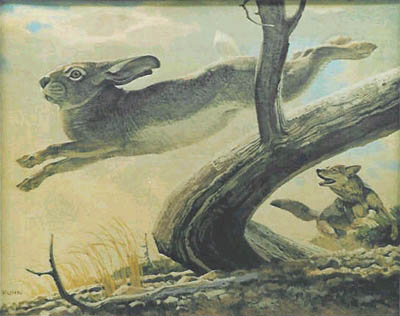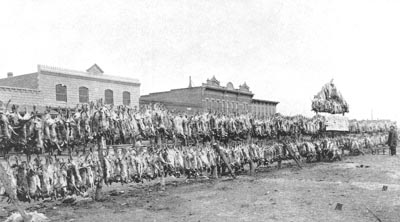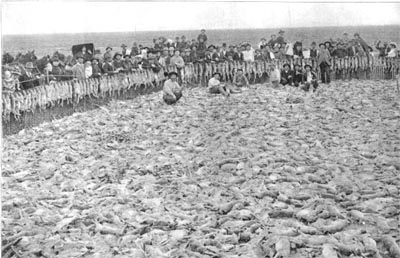 A repost from this blog circa February 2006.A Jack Rabbit is not a rabbit -- it is a hare.
A repost from this blog circa February 2006.A Jack Rabbit is not a rabbit -- it is a hare. The name comes from the fact that early settlers distinguished this animal from the various forms of cotton tail rabbits by comparing the ears of this hare to that of a jack ass. A "jack ass rabbit" became, in time, a "jack rabbit".
American jack rabbits come in two basic flavors -- white-tailed jack rabbits and black-tailed jack rabbits. There is also the snowshoe hare, but it is uncommon in the U.S. which is the southern terminus of its range.
Jack rabbits are so common in much of the drier parts of the American west that in most states the law says you can kill as many as you want, any way you want, on your own property.
Long gunners kill about 2 million jack rabbits in California every year, and the numbers are not in decline as a consequence. Kills by coursing dogs, such as greyhounds, are so rare they do not even register in the statistics.
Truth be told, it is hard to make a dent on jack rabbit populations because they are as prolific as .... well rabbits. Female jack rabbits breed for about half the year (January to July) and have 3 or 4 litters a year with three or four young on average. Gestation is 41 to 47 days, and the young are born alive and running, straight out of the box -- there is no den or nest.
The white-tailed jack rabbit is about 8 pounds and a bit larger than its black-tailed cousin. Fox eat almost no jack rabbits (too big and fast for a fox to catch), but coyotes take quite a few. The main enemy of the jack rabbit is
tularemia -- an ugly little disease, and not a very nice way to die.
Jack rabbit hunts are an old tradition in the American West. Hunting them with dogs, however, is certainly less efficient and more sporting than the way it once was done!
The old-fashioned American jack rabbit hunts that
occurred in the West were done with snow fencing that would stretch out for a mile or two in a large funnel. Rabbits would then be driven into the funnel and the rabbits would then be penned at the end of the funnel and clubbed to death.
 The picture above is of an 1893 Fresno, California bunny roundup with snow fence used as a "boma" to corral the rabbits.
The picture above is of an 1893 Fresno, California bunny roundup with snow fence used as a "boma" to corral the rabbits.
Some jack rabbits were eaten, but the real reason for the jack rabbit roundup was that 15 jack rabbits could supposedly eat about as much as a cow, and while there was a market for cattle hide and salted beef, there was no market for jack rabbit.
Jack rabbit roundups in the American west were not hunting -- they were a failed attempt at extermination.
 1894 jack rabbit haul from Lamar, Colorado.
1894 jack rabbit haul from Lamar, Colorado.
The first greyhound coursing clubs in the U.S. were a product of the massive rabbit drives pictured above. The healthiest rabbits taken in a jack rabbit drive were sold to coursing clubs (some are far away as Florida!). Today, the live rabbits that were once used in open fields, have been replaced with race tracks in which a mechanical bunny runs down an elevated track. In less formal "lure coursing" trials, a plastic bag is tied to a moving string run across a motor fly wheel and pulleys.
 20,000 rabbits taken in one Fresno, Califonira Jack Rabbit roundup, 1893Around the turn of the 20th Century,
20,000 rabbits taken in one Fresno, Califonira Jack Rabbit roundup, 1893Around the turn of the 20th Century, the federal government put most of the American West in control of the Bureau of Land Management, the U.S. Forest Service, various Indian reservations, and the military. Federal protection of these environmentally marginal lands has meant that jack rabbits have been allowed to breed unfettered by cattlemen for about 100 years now. The cow at
McDonald's is probably a feed-lot animal, not a free-range western cow competing head-to-head with jack rabbits. In short, the jack rabbit has never had it so good.
A few greyhounds are still used to course jack rabbits in the West, but they are not much of a threat to jack rabbit populations. The reason for that is pretty simple: A jack rabbit can hit speeds of 40-45 mph and turn on a dime. The few rabbits that are caught are easily replaced through natural reproduction.
In fact, getting chopped by a greyhound may be the best of all possible exits for a jack rabbit. The alternative death is not a hospital bed with a morphine drip and soft music in the background, but debilitating disease, vehicle impact, starvation, or being ripped apart by a coyote, owl, and/or the blast of a shotgun or a .22 rifle. In the litany of ways a rabbit can die, a chop by a practiced greyhound is a good way to go.
.




















